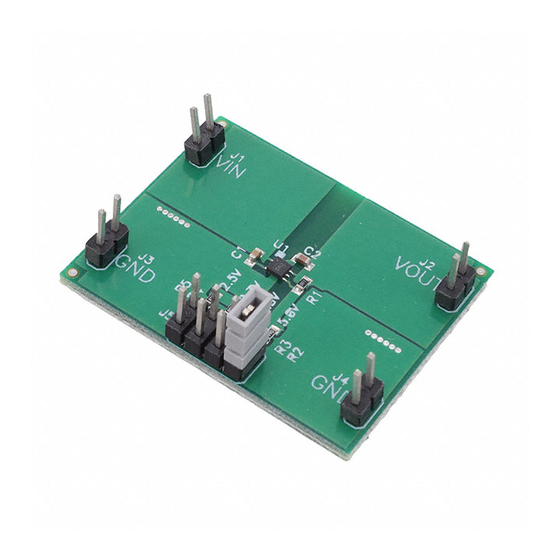
Advertisement
Quick Links
This user's guide describes the characteristics, operation, and use of the TPS71401DRVEVM-426
evaluation module. This document includes setup instructions, a schematic diagram, thermal guidelines, a
bill of materials (BOM), and printed circuit board (PCB) layout drawings.
......................................................................................................................
1
Overview
..........................................................................................................................
2
Setup
.....................................................................................................................
3
Operation
4
Thermal Guidelines
5
Board Layout, Schematic, and Parts List
1
Assembly Layer
2
Top Layer Routing
3
Bottom Layer Assembly
4
Bottom Layer Routing
5
TPS71401DRVEVM-426 Schematic
1
Overview
This document describes the characteristics, operation, and use of the TPS71401DRVEVM-426
evaluation module (EVM). This EVM demonstrates the capabilities and features of Texas Instruments'
TPS71401, a low-dropout (LDO) linear regulator, an 80-mA, low quiescent current linear regulator in a
2-mm x 2-mm SON package. The TPS71401DRVEVM-426 EVM helps designers evaluate the operation
and performance of the TPS71401 LDO in a variety of configurations.
1.1
Related Documentation from Texas Instruments
The following related documents are available through the Texas Instruments web site at
http://www.ti.com.
All trademarks are the property of their respective owners.
SBVU013 – January 2009
Submit Documentation Feedback
..........................................................................................................
.................................................................................
List of Figures
..............................................................................................................
...........................................................................................................
.....................................................................................................
.......................................................................................................
......................................................................................
Table 1. Related Documentation
Part Number
TPS71401
TPS71401DRVEVM-426
Contents
Literature Number
SBVS116
User's Guide
SBVU013 – January 2009
TPS71401DRVEVM-426
1
2
3
3
4
5
6
7
8
9
1
Advertisement

Summary of Contents for Texas Instruments TPS71401DRVEVM-426
- Page 1 (EVM). This EVM demonstrates the capabilities and features of Texas Instruments' TPS71401, a low-dropout (LDO) linear regulator, an 80-mA, low quiescent current linear regulator in a 2-mm x 2-mm SON package. The TPS71401DRVEVM-426 EVM helps designers evaluate the operation and performance of the TPS71401 LDO in a variety of configurations.
- Page 2 J5. The preprogrammed output voltages are configured as shown in Table Table 2. Output Voltage Setting Output Voltage (V) Jumper Between Pins 1 and 2 3 and 4 5 and 6 7 and 8 TPS71401DRVEVM-426 SBVU013 – January 2009 Submit Documentation Feedback...
- Page 3 EVM board. Thermal Guidelines This section presents guidelines for the thermal management of the TPS71401DRVEVM-426 PCB. Thermal Considerations Thermal management is a key design component of any power converter application and is especially important when the power dissipation in the LDO is high.
- Page 4 Temperature Maximum Ambient Output Voltage (V) Temperature (°C) Board Layout, Schematic, and Parts List This section provides the TPS71401DRVEVM-426 board layout and illustrations. It also includes the schematic and bill of materials for the EVM. PCB Layouts Figure 1 through Figure 3 show the layout for the TPS71401DRVEVM-426 PCB.
- Page 5 Board Layout, Schematic, and Parts List www.ti.com Figure 1. Assembly Layer SBVU013 – January 2009 TPS71401DRVEVM-426 Submit Documentation Feedback...
- Page 6 Board Layout, Schematic, and Parts List www.ti.com Figure 2. Top Layer Routing TPS71401DRVEVM-426 SBVU013 – January 2009 Submit Documentation Feedback...
- Page 7 Board Layout, Schematic, and Parts List www.ti.com Figure 3. Bottom Layer Assembly SBVU013 – January 2009 TPS71401DRVEVM-426 Submit Documentation Feedback...
- Page 8 Board Layout, Schematic, and Parts List www.ti.com Figure 4. Bottom Layer Routing TPS71401DRVEVM-426 SBVU013 – January 2009 Submit Documentation Feedback...
- Page 9 Board Layout, Schematic, and Parts List www.ti.com Schematic and BOM Figure 5 illustrates the TPS71401DRVEVM-426 schematic. Table 4 lists the bill of materials for this EVM. Figure 5. TPS71401DRVEVM-426 Schematic SBVU013 – January 2009 TPS71401DRVEVM-426 Submit Documentation Feedback...
- Page 10 Board Layout, Schematic, and Parts List www.ti.com (1) (2) (3) Table 4. TPS71401DRVEVM-426 Bill of Materials Count RefDes Value Description Size Part Number 0.1 µF Capacitor, Ceramic, 0.1-µF, 16-V, X7R, 10% 2.2 µF Capacitor, Ceramic, 2.2-µF, 10-V, X7R, 10% J1, J2,...
- Page 11 EVALUATION BOARD/KIT IMPORTANT NOTICE Texas Instruments (TI) provides the enclosed product(s) under the following conditions: This evaluation board/kit is intended for use for ENGINEERING DEVELOPMENT, DEMONSTRATION, OR EVALUATION PURPOSES ONLY and is not considered by TI to be a finished end-product fit for general consumer use. Persons handling the product(s) must have electronics training and observe good engineering practice standards.
- Page 12 IMPORTANT NOTICE Texas Instruments Incorporated and its subsidiaries (TI) reserve the right to make corrections, modifications, enhancements, improvements, and other changes to its products and services at any time and to discontinue any product or service without notice. Customers should obtain the latest relevant information before placing orders and should verify that such information is current and complete.
















Need help?
Do you have a question about the TPS71401DRVEVM-426 and is the answer not in the manual?
Questions and answers